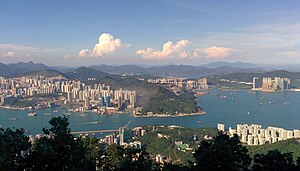
Summary
Lei Yue Mun is a short channel in Hong Kong. It lies between Junk Bay and Victoria Harbour, separating Kowloon and Hong Kong Island. The channel is an important passage for the city, forming the eastern entrance of Victoria Harbour.
| Lei Yue Mun | |||||||||||||||
|---|---|---|---|---|---|---|---|---|---|---|---|---|---|---|---|
 Lei Yue Mun, viewed from Mount Parker | |||||||||||||||
| Traditional Chinese | 鯉魚門 | ||||||||||||||
| Simplified Chinese | 鲤鱼门 | ||||||||||||||
| Literal meaning | Carp Gate | ||||||||||||||
| |||||||||||||||





The lands around the channel are also called Lei Yue Mun. On Kowloon side, it is famous for its seafood market and restaurants in the fishing villages.[1] On the Hong Kong Island side, it has former military defence facilities.
Names edit
The Chinese name for the channel means "Carp Gate"[2] and is pronounced Lei5 yu4 mun4 in Cantonese. It has been variously transcribed and translated over the years, appearing as the Ly-ce-moon Pass,[3] the Ly-ee-moon Pass,[4] Ly-e-Mun Pass,[5] Lyemun, Lymoon, and the Lye Moon Passage.[citation needed]
Places and facilities edit
- On Hong Kong Island
- Lei Yue Mun Fort, converted into the Hong Kong Museum of Coastal Defence
- Lyemun Barracks, converted into the Lei Yue Mun Park and Holiday Village
- On Kowloon
- Lei Yue Mun Village (鯉魚門村):
- Ma Pui Tsuen (馬背村)
- Ma San Tsuen (媽山村)
- Ma Wan Tsuen (馬環村)
- Sam Ka Tsuen (三家村)
- Sam Ka Tsuen Typhoon Shelter (三家村避風塘)
- Tin Hau temple,[6] a Grade II historic building in Ma Wan Tsuen (馬環村).[7] The temple was built in 1753 and completely reconstructed in 1953. A Hip Tin Temple adjacent to the Tin Hau Temple was added after 1953 for the worship of Kwan Tai.[8]
- Old Quarry Site Structures, listed as Grade III historic buildings.[9]
- Lighthouse[10]
- Wish Tree[11]
- Lei Yue Mun Municipal Services Building (鯉魚門市政大廈)
- Lei Yue Mun Estate, a public housing estate in Yau Tong
- Domain and Lei Yue Mun Plaza, shopping malls
Transportation edit
- Ferry: Coral Sea Shipping Services (珊瑚海船務) provides a regular service between Sam Ka Tsuen pier and Sai Wan Ho pier. Fare is HK$9 per adult.
- Bus: Kowloon Motor Bus operates circular bus route no. 14X between Sam Ka Tsuen and Tsim Sha Tsui
- Minibus: Red minibus service is available between Kwun Tong and Lei Yue Mun, and between Mong Kok and Lei Yue Mun.
- MTR: Yau Tong station (Kowloon side)
Education edit
Lei Yue Mun is in Primary One Admission (POA) School Net 48. Within the school net are multiple aided schools (operated independently but funded with government money) and Kwun Tong Government Primary School.[12]
See also edit
References edit
- ^ Fun in Kwun Tong - Lei Yue Mun Seafood Bazaar
- ^ Chan, S.-H.; Ip, I.-C.; Leung, L. Y. M. (2006). "Negotiating culture, economics and community politics : the practice of Lei Yue Mun tourism in postcolonial Hong Kong practice of Lei Yue Mun tourism in postcolonial Hong Kong". Cultural Studies Review. 12 (2): 109. doi:10.5130/csr.v12i2.2339.
- ^ MacDonald, A. (1881). . Encyclopædia Britannica, Ninth Edition – via Wikisource.
- ^ Chisholm, Hugh, ed. (1911). . Encyclopædia Britannica. Vol. 13 (11th ed.). Cambridge University Press. pp. 657–659.
- ^ "Passenger Ships Owned by the United States Government". GG Archives. United States Shipping Board Emergency Fleet Corporation (United States Lines). Retrieved 31 May 2020.
- ^ Fun in Kwun Tong - Tin Hau Temple in Lei Yue Mun
- ^ List of Graded Historic Buildings in Hong Kong (as at 6 November 2009) Archived 9 July 2011 at the Wayback Machine
- ^ Brief Information on No Grade Items, pp.418-419 Archived 2012-10-15 at the Wayback Machine
- ^ Antiquities Advisory Board. List of new items for grading assessment with assessment results
- ^ Fun in Kwun Tong - Lei Yue Mun Lighthouse
- ^ Fun in Kwun Tong - Lei Yue Mun Wishing Tree
- ^ "POA School Net 48" (PDF). Education Bureau. Retrieved 2022-09-12.
External links edit
- Harbourfront Enhancement Committee "Revitalizing Lei Yue Mun", October 2009
- Tourism Commission website: "Lei Yue Mun Waterfront Enhancement Project"
- Antiquities Advisory Board. Historic Building Appraisal. Old Quarry Site Structures, Lei Yue Mun, Kwun Tong, Kowloon Pictures
22°17′5″N 114°14′18″E / 22.28472°N 114.23833°E


